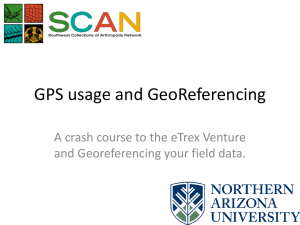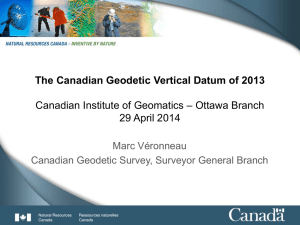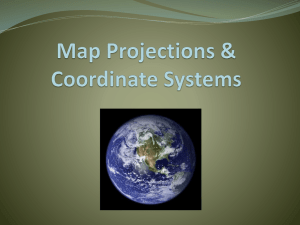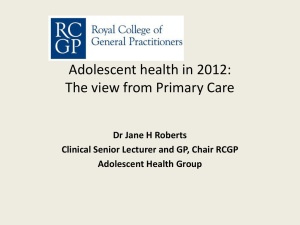A. NAD83 (2011) - Spatial-Ed
advertisement
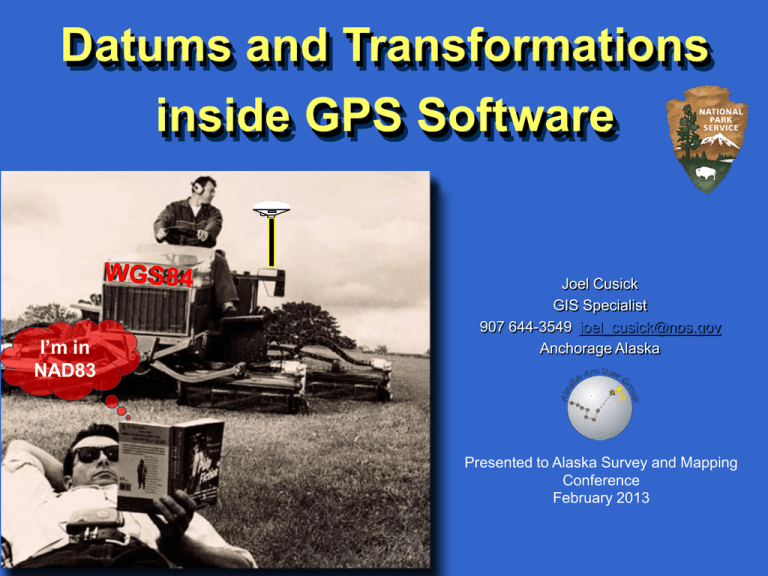
Datums and Transformations inside GPS Software I’m in NAD83 Joel Cusick GIS Specialist 907 644-3549 joel_cusick@nps.gov Anchorage Alaska Presented to Alaska Survey and Mapping Conference February 2013 Audience Poll Who Uses? – Garmin devices? – Answer about 15 – Mapping Grade GPS (submeter)? – Answer about 15 – ArcPad? Answer about 15 – Real-time Coast Guard Beacon Signals (NDGPS)? Answer – no one. 2 Common Datums in Alaska NAD27 - Pre-GPS; Digitized Topos NAD83* - GPS; Mandated for US(&AK!) WGS84 - Used by GPS satellites ITRF00/IGS08 - Global reference/ CORS * http://www.ngs.noaa.gov/PUBS_LIB/FedRegister/FRdoc95-19408.pdf 3 Over Time Datums Grew Apart Today NAD 83 ≠ WGS84 1986 NAD83 = WGS84 Anchorage 1.3 Meters (4.2 feet) WGS84 = ITRF00 = IGS08 4 Today, You Have to Go Back NAD83 ITRF00 or 1GS08 NAD83 (CORS96) Or NAD83 (2011) Anchorage 1.3 Meters (4.2 feet) 5 Latest Datum Frame Adjustments WGS84 (G1640) WGS84 1986 - Original WGS84 (G730) 1992 WGS84 (G873) 1997 WGS84 (G1150) 2002 NAD83 (2011) NAD83 (1986) - Original NAD83 (1992) HARN NAD83 (1994) CORS NAD83 (2007) 6 The Most Important NAD83’s for An Alaskan GIS NAD83 (1986) NAD83 (CORS96) epoch 2003.0 NAD83 (2011) epoch 2010.0 Datum Name Tag Epoch 7 Difference between WGS84 (G1150) and NAD83(CORS96) at 2003.0 Horizontal difference 8 Used with permission by Author: Michael Dennis “NAD83 To WGS84” SHIFT Originally WGS84 and NAD83 were essentially the same. Both datums continually refined through time - today they differ by 1-2 Meters There are specific times (epochs) where the “NAD83 and WGS84/ITRF00/IGS08” pairs are borne, hence specific transformations built (time dependent) Finding information on what Shifter to use is tricky…. See Dave Doyle’s Datum Course this Friday 9 GPS Receiver Accuracies Do datum shifts really matter? Next two slides: multi-year accuracy evaluation 10 Garmin Accuracy with WAAS N=2930 Mean 1.1 Meters STD: 0.6 Meters *Horizontal diff (m) measured between OPUS controls and students Garmin Map76CSx(int. antenna) set to active track (1 point / sec) . Stats using NEAR Tool projected in NAD83 (CORS96) UTM Zone 6 CS. 11 Mapping Grade GPS Accuracies* Fairbanks Feb 2010; March 2011 N=136 points (680 positions) Mean 0.61 Meters; STD: 0.69 Meters Copper Center June 08’;May 09’;June 12’ N=95 points (465 positions) Mean 0.57 Meters; STD: 0.85 Meters Anchorage June 08’;May 09’;June 12’ N=108 points (540 positions) Mean 0.45 Meters; STD: 0.35 Meters Skagway / Gustavus May 10’; June 11’ N=32 points (160 positions) Mean 0.41 Meters; STD: 0.55 Meters *Horizontal diff (m) measured between OPUS controls and students antenna. Stats using NEAR Tool projected in NAD83 (CORS96) UTM Zone 6 & 8 CS 12 GPS Accuracy vs Datum Shifts A meter + of shift is a big deal for both recreational and mapping grade GPS At decimeter level accuracies 1 cm of shift is starting to become worrisome You will need to shift, so knowledge is key 13 Datums Would Not Be So Bad if It wasn’t for….. Maps and digital forms of maps….GIS!!! All Feds are mandated to “sic transition to NAD83” If we always kept our GPS data on the receiver…. * http://www.ngs.noaa.gov/PUBS_LIB/FedRegister/FRdoc95-19408.pdf 14 Basic Premise with GPS Software Most assume you are in “WGS84” Most offer transformations to go back and forth (sign switching) Many offer a “do nothing” shift. Parameters are zero! ESRI calls these “bookkeeping transforms” Most software assumes when sending data to a GPS, a shift back to WGS84 occurs. This is unlike the GIS paradigm, where WGS84 is just one of many datums to choose from 15 What is a geographic transformation? Geographic Transformations – – Mathematical calculation that is used to convert coordinates referenced from one datum to coordinates referenced to another datum NGS designs transformations – Designed for specific epochs See Dave Doyle’s presentation on Friday! 16 Geographic Transformations: Choice to Do Nothing or Something Depends on your realtime correction source, CORS reference frames and your GIS 17 The Problem with Shifters Different software companies and organizations use different libraries The verbose titles of the shifters can be different, yet rely on the same math…. For Example Trimble’s 0,0,0 Shifter NAD83 (Alaska) ESRI’s 0,0,0 Shifter NAD83_To_WGS84_1 18 Datum Shifting Garmin / DNRGPS Software Trimble GPS Pathfinder Office Software ArcPad GPS Correct/ GPS Analyst 19 Personal Navigation Device (PND) Garmins are the most popular GPS in Alaska NPS (500+ units) 1-3 meter accuracy w/ WAAS differential High support, reliable, rugged, cheap Free GIS software (DNRGPS – formerly DNRGarmin) Ideal for Navigating to sample sites, control monumentation 20 Garmin Datum Primer Garmins receivers and software assume WGS84=NAD83 You will shift a meter (1+) relative to properly shifted NAD83 if you write down a coordinate If you write, you may lose!* Go Digital and Always use DNRGPS for data transfer! * Shifts of up to 9 meters possible when setting a Garmin to Alaska NAD27 – Never, never use NAD27. 21 Garmins: What Do you Do? GPS NAD83 To WGS84_5 NAD83 To WGS84_5 GIS 22 Garmins: Shift Using “ _5” Set Projection Parameters match ESRI’s NAD83 _ To_WGS84 _5 Officially: ITRF96 to NAD83 at 1997.0* *Paper: http://www.ngs.noaa.gov/CORS/Articles/SolerSnayASCE.pdf ,Table 1, 23 page, 51, Last column Garmins: What Do you Do? Stay consistent and use “_5” for all Garmin data management Tag Garmin data as Plain “NAD83” (PRJ file) Higher quality shifters have little effect : 1cm or less (Don’t worry!) 24 Garmin Datum Summary Garmins don’t care about NAD83 (You will lose a meter + when writing down a “NAD83” coordinate from the screen) Always use DNRGPS and set Projection Tag Garmin data as “NAD83” and use metadata to store your workflow Use of Garmin software like MapSource, Basecamp are not recommended for GIS purposes 25 Datum Shifting Garmin / DNRGPS Software Trimble GPS Pathfinder Office Software ArcPad GPS Correct/ GPS Analyst 26 Our CORS Network – Part of the National Spatial Reference Frame 27 Mapping Grade GPS Correction Sources Post Process Differential Correction – AFTER the fieldwork is done, correct against a reliable Base Station – A CORS site Real-time Differential – Coast Guard NDGPS Beacon sites – WAAS – VRS???? 28 How Does Corrections Affect Your Data? Corrections are in the terms of the correction source reference frame (Datum) The key is knowing the datum referenced for the correction source – WHY? When you differentially correct, you MOVE your data to the corrected data’s datum – You might have to apply a geographic transformation if your differential correction source datum is different than your database’s datum 29 Which Datum Are You In? WGS84 = IGS08 (G1640) (2005) NAD83 (2011) epoch 2010.0 - CORS Post Processed - CORS Post Processed - Autonomous GPS - NDGPS (Beacon) - WAAS - OMNISTAR (Satellite) 30 Datum of Base Station Becomes Datum of Corrected File Your GPS data MOVES It can be in ITRF00 (1997.0) or NAD83(CORS96) (2003.0) 31 Datum of Base Station Becomes Datum of Corrected File Your GPS data MOVES It can be in IGS08 (2005.0) or NAD83(2011) (2010.0) 32 PostProcess Differential Correction When selecting “Use reference position from base files” the coordinate system depends on what the owner of the base station stored in RINEX header For CORS the corrected data file references NAD83(2011) epoch 2010.0 ARP – Check the New Coordinates page for the CORS station to verify the position 33 PostProcess Differential Correction When selecting “Use reference position from base provider” the WGS84 (ITRF00- Derived from IGS08) is used 34 What does this mean? Let me state this again – Your GNSS data MOVES when you differentially correct SHIFT DEMO – differential correction Trimble GPS Pathfinder Office ESRI ArcGIS 10.1 35 SHIFT DEMO ESRI ArcMap 10.1 *OPUS Control compliments of Eric Oppegard (JOA Associates) 36 ArcMap DEMO– Uncorrected data About 1.5 m from the 83 (CORS96) EPOCH: 2003 monument 37 Diff. Correcting w/ CORS ITRF00 (1997) 38 Results – 12 cm from 83 (CORS96) 39 Results - Zoom In 40 Diff. Correcting w/ CORS NAD83 (CORS96)* Evaluate another pathway *Must create own Base Station with Older NAD83 (CORS96) Coordinates 41 Results – 11 cm from 83(CORS96) 42 Diff. Correcting w/ Latest NAD83 (2011)* Use Base File option populated with the latest NAD83 (2011) * NAD83 (2011) Coordinates are embedded in the RINEX header of base file 43 Results – 14 cm inches from 83(CORS96) 44 What 8 years can do to your coordinates - ~ 13 cm *HDTP to transform from ITRF00(1997) to IGS08(2005) 45 Trimble: What Do you Do? GPS GIS Defined as NAD83 (2011) Use Base File NAD83 (2011) Export using NAD83 (Alaska) 46 Trimble: What Do you Do? GPS Seed NAD83 (CORS96) 2003 GIS Defined as NAD83 (CORS96) Export using NAD83 (Alaska) 47 Trimble: What Do you Do? GPS GIS Defined as NAD83 (2011) Already NAD83 (2011) Export using NAD83 (Alaska) 48 HOT TIP: How to create your own base station GoTo ngs.noaa.gov/CORS Select Coordinates for a CORS Station Select the Position and Velocity link Copy an Existing CORS coordinates Seed Coordinates into Base Provider Reference Position 49 HOT Tip – Batch Processing Automate Base Station Coordinates and Export utilities together Ensures fewer mistakes are made. Insert Movie file JCusick_Datums andTransformati onsinGPSSoftwa re_MovieofBatch Processing.avi 50 Final Word on Mapping Grade Datum Shifts Michael Dennis (A real Geodesist from NGS) says it best…. – “If you want your results in NAD 83, then use the published NAD 83 values as seed coordinates. Relying on all this tricky and confusing transformation/velocity business is just asking for trouble. Joel Cusick (A biologist from NPS) says it this way…. – “Doing the right thing” use only CORS stations and PFO software, “Use reference position from base file” option with the NEW Position in NAD83 (2011). Finally, during export use the NAD83 (Alaska) shifter and assign the data as NAD83 (2011) (e.g. NAD 83 (2011) UTM Zone 6N). 51 Mapping Grade Software Summary More choices exist in mapping grade software to hold, transform and export to a CORS reference frame Always verify the coordinates for CORS and seed the published NAD83 values if you have too Define all exports precisely to match the CORS published values 52 Datum Shifting Garmin / DNRGPS Software Trimble GPS Pathfinder Office Software ArcPad GPS Correct/ GPS Analyst 53 Which Datum Are You In? WGS84 = IGS08 (G1640) (2005) NAD83 (2011) epoch 2010.0 - CORS Post Processed - CORS Post Processed - Autonomous GPS - NDGPS (Beacon) - WAAS - OMNISTAR (Satellite) 54 ArcPad VS TerraSync :Opposites ArcPad – Change the GPS Datum to the correction source’s datum – This shifts your data on the device from correction source to your map (output datum) TerraSync – Keep the datum at WGS 84 – This will shift your data to the correction source’s datum – If you change the datum to the correction source’s datum, your data will shift to the WGS 84 that the satellites use 55 3 ArcPad Workflows ArcPad autonomous or w/ WAAS ArcPad w/ GPScorrect w/Real-time network or local base station ArcPad w/ GPScorrect, post-processed in GPS Analyst 56 Understanding ArcPad w/ Autonomous GPS or WAAS ArcPad MUST have 3 pieces of information: – Input GPS datum – Output datum – Transformation parameters 57 ArcPad with WAAS Input GPS Datum = WGS 84 58 ArcPad with WAAS Set Output datum –defined by .prj from shapefile or feature class 59 ArcPad with WAAS Transformation – Check the transformation 60 ArcPad with WAAS Parameters match ESRI’s NAD83_To_WGS84_5 Officially ITRF96 to NAD83 at 1997.0 *Paper: http://www.ngs.noaa.gov/CORS/Articles/SolerSnayASCE.pdf ,Table 1, page, 51, Last column 61 ArcPad Problem with NAD 83 CORS 96 or NAD83(2011) Proper Datum Transformation not available 62 ArcPad: Create own Transform on device if using CORS Must use the Datum Configuration tool Just realize if you are using default ArcPad shifters, all your data got to NAD83 from WGS84 using ITRF96 to NAD83 at 1997.0 shifter Got it! 63 ArcPad Summary Don’t forget the 3 pieces: Input Output Transformation Anytime you use other correction sources, must know when NOT to shift or shift with a custom datum transformation tool. 64 Metadata: Don’t Wait! Promotes Accurate Data Sharing Any GPS project should specify the following – – – – – Device Used Correction Applied (if any) Field and PC software used CORS station held CORS Realized Datum Reference and Epoch held Important to conduct a survey check (more on this later) 65 Metadata for a Garmin Bad – Waypoints collected with a Garmin. Lat/Long set to NAD83 Datum from display screen. Accuracy is 510 meters Good – Field data collected using Garmin Map76CSx with WAAS enabled. All points averaged for minimum of 10 seconds. All data downloaded and saved to shapefile using DNRGPS with Set Projection of Alaska Albers 83 (POSC 3338). During course of project, survey check data collected on nearby PID (TT7584) using active tracklog for 180 seconds (1pps). CEP calculated at 1.2 Meters 66 Metadata for a Mapping Grade Bad – All data collected by biologists (we all have Ph.D.’s) with $10K GPS and saved in Excel spreadsheets. No idea what Datum the data is in…. Good – Field data collected by field crews with Trimble GeoExplorer 6000 receivers running TerraSync 5.2 field software. All points collected with internal antenna at 1 second interval for 5 seconds each. Data processed with Pathfinder Office(v5.2) with CORS Kenai (KEN5) holding the NAD83 (2011) at epoch 2010 realization. Data exported to geodatabase using NAD83(Alaska) datum in UTM Zone 6N. Assigned as NAD83(2011) datum. Survey check conducted on PID TT7658. 95% CI 67 at 33cm. Metadata for ArcPad Projects Bad – Data collected using a GPS and ArcPad with a custom application. Good – GIS data collected by field crews using Toshiba laptops and bluetooth GENEX Sirf Chip GPS receivers. Custom ArcPad 10.0 application developed to enhance data collection. All points collected using WAAS. Data stored as NAD83(CORS96) at 1997.0 epoch using the default _5 transformation in projected NAD83 UTM Zone 6N. Several survey checks conducted before and after survey on PID TT7658. 95% CI at 5.2 Meters. 68 Metadata Light If Dave Doyle (Geodesist – Retired NGS) had a choice. – GPS data collected in 2003. NAD83 (CORS96) 2003.0. Survey check on PID 59967. NSSDA 95% CI 0.33 Meters That’s IT! 69 Export Datum Settings data in GPS Pathfinder Office software NAD 1983 (Conus) or NAD 1983 (Alaska) – 0,0,0 bookkeeping shifters. NAD 1983(Conus)CORS 96 – shifts data to CORS 96 – Based on NAD83_To_WGS84(CORS96) BE CAREFUL – you can double shift your data. If your corrected data is already NAD83 (2011), then transform doing NOTHING. 70 Geographic transformations in ArcGIS 10.0 – For Alaskans NAD_1983_To_WGS_1984_1 - North America This is a ZERO transformation NAD_1983_To_WGS_1984_2 - Aleutians NAD_1983_To_WGS_1984_3 - Hawaii NAD_1983_To_WGS_1984_4 - 48 contiguous states (superseded by _5) NAD_1983_to_WGS_1984_5* Officially ITRF96 To NAD83 at 1997.0 NAD_1983_To_WGS_1984_6, _7, and _8 are NTv2 transformations for Quebec, Saskatchewan, and Alberta, respectively. WGS_1984_(ITRF00)_To_NAD_1983 – applies a shift from ITRF00 to NAD 83(CORS96) at 1997.0** * http://www.ngs.noaa.gov/CORS/Articles/SolerSnayASCE.pdf Table 1, page, 51, Last column ; **Table 2, page 52 71 TOP Three Shifters for Modern GPS in ArcGIS 10.1 NEW NO SHIFT OLD Choose the one that has zero translations or matches the reference frame of your data. 72 When geographic transformations help When you have data from two different coordinate systems. Here’s an example with ArcMap data in WGS84 (ITRF00 1997.0) and MUNI imagery is assigned UTM NAD 83 73 No transformation – See the Shift! 74 Zoomed in 75 Geographic transformation applied 76 1.2 Meter Shift Resolved WGS84 NAD83 77 This Could Work A lot Better! If the Ortho was defined as NAD83 CORS96 (epoch 2003.0) Don’t settle for modern GPS-based products (like orthos) to be assigned “NAD83” It’s time to get more precise 78 NAD83 Quiz Which NAD83 for NAD27 data NADCON’d to NAD83 (source from TOPOS) – A. NAD83 (Plain) Which NAD83 for Garmin data you collected – A. NAD83 (Plain) Which NAD83 for mapping grade data from 3 years ago (holding a CORS position) – A. NAD83 (CORS96) epoch 2003.0 Which NAD83 for an ORTHO you are flying this year? – A. NAD83 (2011) epoch 2010.0 79 NAD83 (2011) – Same Datum, New Reference Epoch OPUS reports out NAD83 (2011) EPOCH 2010. 7 Parameters to go between IGS08 and NAD83 (2011) are published* Same 7 parameters are in most software (ESRI), Trimble (CSM) Define your data as NAD83(2011) IF you are really based on that new reference EPOCH. It’s here to stay…. Until 2022….** *http://www.ngs.noaa.gov/CORS/coords.shtml#KEYEPOCH ** See Handout from NGS on Coordinate and Height Changes 80 Always Check! – How To Conduct A Survey Check Find a GPS quality survey marker (PIDs) Pay attention to the survey control reference frame (Datum name and epoch) Differentially correct holding same CORS reference frame Export using appropriate shifter (or NOT!) Compare coordinates from the data sheet to your coordinates in Esri ArcMap Apply appropriate shifter (or NOT!) Use Measure Tool and Statistics 81 Conclusion Know where your are going and how you got there ! If your wrong, stay consistent. Stay wrong until you shift everything at once Write Accurate Metadata All data must be tagged with Epoch to ensure you can get back (NAD83(CORS96) 2003.0 Always Check Yourself to Gain Confidence in your GPS Accuracy and Using the Right Datum 82 Acknowledgements Daisy Rettaliata (Duncan Parnell) Michael Dennis (NGS) Giovanni Sella (NGS) Julian Idle (Trimble) Alison Walker (Electronic Data Solutions) Dave Doyle (NGS) Neil Winn (NPS – Assateague NS) Thanks for attending Questions? 84
